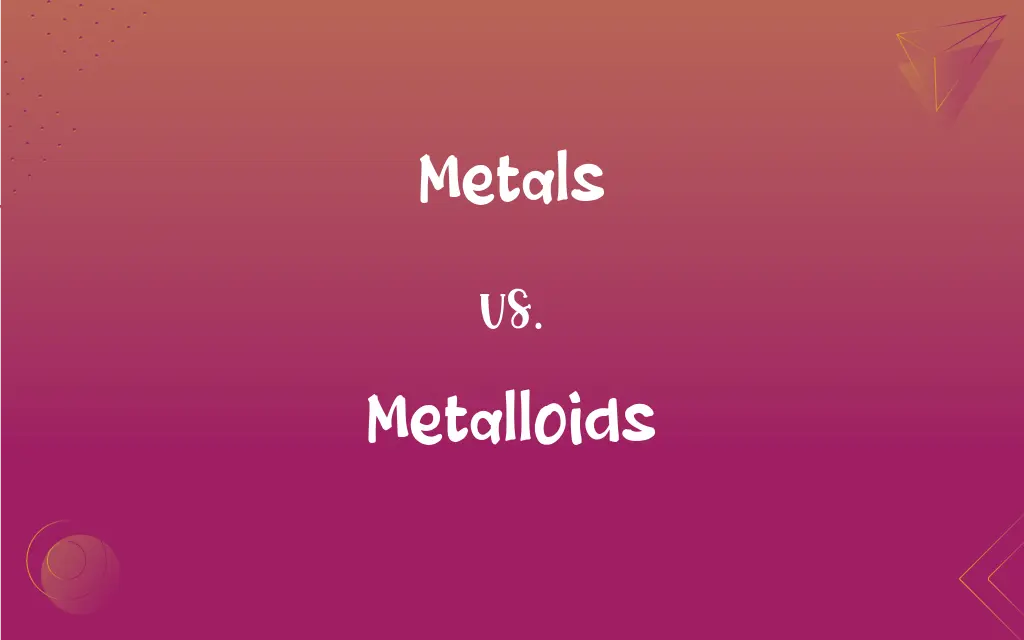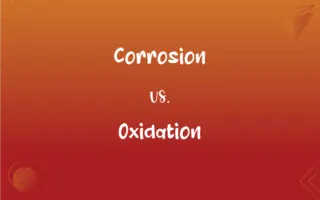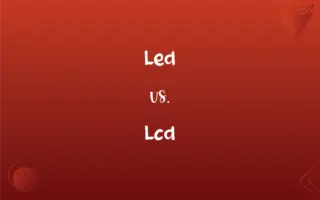Metals vs. Metalloids: What's the Difference?
Edited by Janet White || By Harlon Moss || Updated on October 11, 2023
Metals are elements with high electrical conductivity, malleability, and ductility, while metalloids possess intermediate properties of metals and nonmetals, exhibiting mixed conductivity and appearance.

Key Differences
Metals, forming the majority of the periodic table, and metalloids, scattered sparingly amidst them, exhibit contrasting characteristics despite their adjacency on the periodic chart. Metals commonly boast properties such as high conductivity, malleability, and shininess, while metalloids tend to straddle the line, showcasing a mix of metallic and nonmetallic characteristics. Although metalloids might share some visual aspects with metals, their physical and chemical divergences are rather notable.
Metals, in a generalized sense, are identified for their capacity to conduct electricity and heat with remarkable proficiency, while metalloids navigate a middle ground in this regard. Metalloids might conduct electricity, but not as efficiently as metals, often being semiconductors, pivotal in the electronics industry. Metals are generally ductile and malleable, while metalloids don’t always exhibit these traits, frequently bristling against the easy categorization that metals might slide into.
In an electrochemical context, metals and metalloids do not stand on identical grounds. Metals tend to lose electrons, becoming cations, while metalloids might either lose or gain electrons, thus showcasing their ambivalent nature that metals do not characteristically demonstrate. The chemical behavior of metals is typically predictable, while metalloids defy expectation, moving in a direction that strays from the streamlined path of metals.
Metals, solid, robust, and often dense, contrast against metalloids which might present a divergent physical appearance. Whereas metals mirror each other with their shiny, often silver-gray appearance, metalloids might vary in color and lack the uniform luster that is quintessentially metallic. Metalloids, sitting on the fence between metals and nonmetals, tease aspects from both categories, forming a unique classification that metals do not embody.
While metals and metalloids may neighbor each other on the periodic table, their applications in industries and sciences diverge with noticeable significance. Metals find ubiquitous application in construction, transportation, and utensils owing to their strength and durability, while metalloids often find a niche in the technological and electronic sectors, leveraging their semiconductor properties which metals cannot inherently offer. Both critical to varying industries, metals and metalloids delineate their importance through their disparate properties and applications.
ADVERTISEMENT
Comparison Chart
Electrical Conductivity
High and efficient
Moderate, semi-conductive
Appearance
Generally shiny and lustrous
Can be shiny or dull
Malleability and Ductility
Often malleable and ductile
Less malleable and ductile
Electron Movement
Tend to lose electrons
Can either gain or lose electrons
Common Applications
Construction, utensils
Electronics, semiconductors
ADVERTISEMENT
Metals and Metalloids Definitions
Metals
Metals are elements, compounds, or alloys characterized by high electrical conductivity.
Copper and aluminum are metals widely used in electrical wiring.
Metalloids
Metalloids have the capacity to either gain or lose electrons in chemical reactions.
Boron, a metalloid, can form covalent compounds by sharing electrons.
Metals
Metals generally display notable malleability and ductility, allowing them to be shaped without breaking.
Metals such as lead are highly malleable and can be formed into sheets.
Metalloids
Metalloids typically act as semiconductors, allowing them to be used in electronic devices.
Germanium, a metalloid, is utilized in transistors and semiconductors due to its electrical properties.
Metals
In a chemical context, metals readily lose electrons to form cations.
When reacting with oxygen, metals like iron lose electrons and corrode.
Metalloids
Metalloids can appear either lustrous or dull, demonstrating a range in physical appearance.
Arsenic, a metalloid, exhibits a metallic luster, unlike some other metalloids.
Metals
Metals typically exhibit a shiny, lustrous appearance.
The metals like gold and silver have been valued for their luster and rarity.
Metalloids
Metalloids are elements that exhibit properties intermediate between metals and nonmetals.
Silicon, one of the metalloids, is widely used in the semiconductor industry.
Metals
Metals tend to be solid, (with the exception of mercury,) and often are hard and dense.
Despite being metals, lithium and potassium are soft and can be cut with a knife.
Metalloids
Metalloids generally have melting points and densities that are higher than nonmetals but lower than metals.
Antimony, a metalloid, has a lower melting point than many metals, making it useful in alloys like pewter.
Metals
Any of a category of electropositive elements that usually have a shiny surface, are generally good conductors of heat and electricity, and can be melted or fused, hammered into thin sheets, or drawn into wires. Typical metals form salts with nonmetals, basic oxides with oxygen, and alloys with one another.
Metalloids
A nonmetallic element, such as arsenic, that has some of the chemical properties of a metal. Most metalloids behave as semiconductors.
Metalloids
A nonmetallic element, such as carbon, that can form an alloy with metals.
Metalloids
Relating to or having the properties of a metalloid.
Metalloids
Having the appearance of a metal.
Metalloids
Plural of metalloid
FAQs
What is the primary characteristic of metals?
Metals are characterized by their high electrical and thermal conductivity.
Do all metals have a shiny appearance?
Most metals exhibit a shiny, lustrous appearance, although some can tarnish or corrode.
Why are metals often used in construction?
Metals are used in construction due to their strength, durability, and ability to withstand environmental conditions.
Are metalloids good conductors of electricity?
Metalloids are generally semiconductors, meaning they conduct electricity to a degree, but not as efficiently as metals.
Is aluminum a metal or a metalloid?
Aluminum is categorized as a metal, noted for its lightweight and anti-corrosive properties.
Is iron considered a metal?
Yes, iron is considered a metal, noted for its strength and magnetic properties.
Are metalloids used in LED technology?
Yes, some metalloids, such as gallium and arsenic (used together as gallium arsenide), are utilized in producing LEDs.
What characteristic do all metals share?
All metals are good conductors of heat and electricity, demonstrating malleability and ductility.
What is an example of a metal used in jewelry?
Gold is a metal commonly used in jewelry due to its luster and malleability.
Can metalloids be found in consumer electronics?
Yes, metalloids like silicon and germanium are often used in consumer electronics due to their semiconducting properties.
Can metals form cations?
Yes, metals commonly lose electrons and form cations in chemical reactions.
Are metalloids essential in solar technology?
Yes, metalloids like silicon are crucial in solar technology, particularly in the manufacturing of solar cells.
Is arsenic considered a metalloid?
Yes, arsenic is considered a metalloid, exhibiting both metallic and nonmetallic properties.
What role do metalloids play in the technology industry?
Metalloids, especially silicon, play a pivotal role in the technology industry, being used to manufacture semiconductors and transistors.
Are metals typically dense?
Generally, metals tend to be dense, though there are exceptions like lithium, which is quite light.
Do metalloids possess characteristics of nonmetals?
Yes, metalloids possess mixed characteristics of both metals and nonmetals, which is why they are often called semi-metals.
Can metalloids form alloys like metals do?
Yes, metalloids can form alloys, and often enhance the properties of metals when they are alloyed together, such as in the case of silicon enhancing the properties of aluminium.
Which metalloid is prevalent in computer chips?
Silicon is a metalloid widely used in making computer chips due to its semiconductor properties.
Do metalloids appear in the periodic table’s metal section?
Metalloids appear in a staircase-like line on the periodic table, separating metals from nonmetals.
Are metals typically malleable and ductile?
Yes, metals are typically malleable (can be hammered into thin sheets) and ductile (can be drawn into wires).
About Author
Written by
Harlon MossHarlon is a seasoned quality moderator and accomplished content writer for Difference Wiki. An alumnus of the prestigious University of California, he earned his degree in Computer Science. Leveraging his academic background, Harlon brings a meticulous and informed perspective to his work, ensuring content accuracy and excellence.
Edited by
Janet WhiteJanet White has been an esteemed writer and blogger for Difference Wiki. Holding a Master's degree in Science and Medical Journalism from the prestigious Boston University, she has consistently demonstrated her expertise and passion for her field. When she's not immersed in her work, Janet relishes her time exercising, delving into a good book, and cherishing moments with friends and family.































































